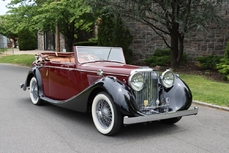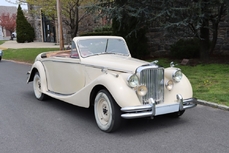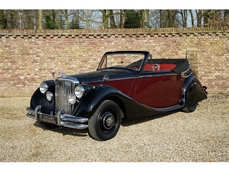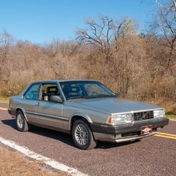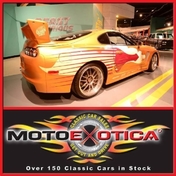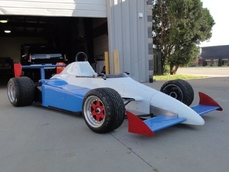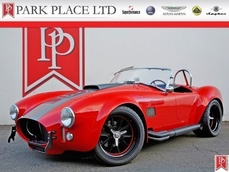Jaguar MkV Drophead Coupé V Drophead 1951
General description :
1951 Jaguar Mark V Drophead Coupe One of only 395 imported examples for 1951 The Mark V was only in production for three years (49-51) Well-cared for and professionally maintained Grey-and-black exterior with Red Leather interior 3.5L inline overhead valve six-cylinder engine with dual SU side-draft carburetors Four-speed manual transmission Girling four-wheel hydraulic drum brakes Fog lights Included with some original tools One could say that the Mark V Drophead Coupe was the XK120 for the sportsman who had a family. From its distinctive pram irons to its coach doors and driving lights, Mot Xotica Classic Cars is proud to present this 1951 Jaguar Mark V Drophead Coupe. It is simply an elegant touring car with a unique presence and three position folding top. This luxurious cat hails from Atherton California.Finished in a distinguished black-and-grey ensemble that highlights the cars curves as well as its chrome trim, including the leaping Jaguar radiator cap mascot. The paint and trim are in very good order but with some minor blemishes upon close inspection.The cars windows are clear and crack-free while its lights, including the fog lights, are haze-free and intact. The bodywork is straight and solid and all looks good. The engine bay is tidy and the cars twin bumpers fit well to the body. There are many original tools in the trunk. This old cat rolls on wide whitewall bias-ply tires, size 6.80-16 at all four corners.Under the hood is a 3.5-liter OHV inline six-cylinder engine with dual SU side-draft carburetors and buttoned to a four-speed, single-helical gearbox from Jaguar and the Moss Gear Company of Birmingham, England. The car features Girling four-wheel hydraulic drum brakes.Inside, the cars red luscious leather interior meshes well with the wood veneer of the instrument panel. The Vaumol Leather seats is in near-excellent order, while the Wilton wool carpet is in very good condition. The four-spoke black steering wheel is in excellent order. The inner door panels and burled walnut instrument panel are in very good order as is the gear selector.Blue Ridge Sports Cars Inc., of North Carolina recently evaluated and serviced this example. While it might look cozy, there is more passenger space available for family and friends to ride to the next cruise night or car show. There, this car would turn a lot of heads.The Mark V retained the 1946-48 driveline, including the overhead-valve pushrod3.5-liter straight-six engines, now since 1946 produced by Jaguar, which the company had previously purchased from the Standard Motor Company before the war. The chassis was new with independent front suspension by double wishbones andtorsion bar an arrangement that would be used by Jaguar for many future vehicles. It also had hydraulic brakes, which Jaguar had been slow to adopt compared to other manufacturers and an all-pressed steel body.The wheels were 16-inch steel-disc type, significantly smaller than the 18-inch wheels on the MK IV. From the side, a distinctive styling touch on the saloon was a tuck in curve at the base of the rear quarter window following the curved profile of the side glass, a feature retained on many subsequent models. Rear-wheel spats (fender skirts) were standard.A 3.5-liter car tested byThe Motormagazine in 1949 had a top speed of 90.7mph and could accelerate from 060mph in 20.4 seconds. Jaguar's inimitable test engineerNorman Dewisused a Mark V regularly. When asked about the top speed he saw in his car, he commented that he verified 90mph once, but the thrill of the moment did not encourage repeating the feat.Competition to this Jaguar in 1950 included Buicks Series 50 Super Convertible, Delahayes 135M Convertible, Hudsons Custom Commodore Eight Convertible Brougham and Mercurys Eight Club Convertible.Drop by Mot Xotica Classic Cars and look this English Rose over for yourself. It is a unique vehicle, even among other classics.This car is currently located at our facility in St. Louis, Missouri. Current mileage on the odometer shows 69,095 miles. It is sold as is, where is, on a clean and clear, mileage exempt California title. GET OUT AND DRIVE!!!PLEASE CLICK HERE TO VIEW OUR YOUTUBE VIDEO!!!!!!!!VIN: 647345Note: Please see full terms and conditions listed below that pertain to the purchase of any said vehicle, thank you.
1951 Jaguar MkV Drophead Coupé V Drophead is listed for sale on ClassicDigest in Bellevue by Specialty Vehicle Dealers Association Member for Not priced.
Car Facts
Car type : Car Make : Jaguar Model : MkV Drophead Coupé Model Version : V Drophead Engine size : 0.0 Model Year : 1951 Location : 13710 NE 20th Street Bellevue, WA 98005 Vehicle Registration : Undefined
Not priced
Seller Information
Specialty Vehicle Dealers Association
Specialty Vehicle Dealers Association Member, Contact no. +1-6366004600
Specialty Vehicle Dealers Association Member, Contact no. +1-6366004600
People who viewed this Jaguar MkV Drophead Coupé also viewed similar Jaguar listed at ClassicDigest
Other cars listed for sale by this dealer
About Jaguar
Ah, the story of Jaguar, from its early days as the SS Cars Ltd. to its pinnacle with the D-type, and the street-going evolution in the form of the iconic E-type. There's something quintessentially British about this tale, and I'll narrate it as a British journalist might.In the Beginnings:
Our journey into the world of Jaguar begins in the 1930s, when a company known as SS Cars Ltd. emerged. Despite the unfortunate coincidence of their initials with the rising political tensions in Europe, they started producing stylish and performance-oriented cars. The SS 100, introduced in 1936, was a symbol of elegance and speed, setting the stage for what would become Jaguar.
The Birth of Jaguar:
As the shadows of World War II loomed, SS Cars Ltd. wisely decided to disassociate themselves from the SS initials. Thus, in 1945, they officially became Jaguar Cars Ltd., a name that would soon be synonymous with British luxury and performance.
The XK Series:
Jaguar's post-war era brought us the XK 120, a true sensation in 1948. With its sleek design and a powerful 3.4-liter inline-six engine, it became the world's fastest production car. The XK 120 was the blueprint for what lay ahead – Jaguars that blended style with speed in a uniquely British fashion.
The D-type Dominance:
Then came the D-type, a true racing legend. Introduced in 1954, it won Le Mans three times in the 1950s, showcasing Jaguar's engineering prowess. With its innovative monocoque construction and the iconic fin at the back, the D-type was the apex of Jaguar's motorsport success.
The E-type Emergence:
But the true turning point arrived in 1961 with the introduction of the E-type, often described by Enzo Ferrari as "the most beautiful car ever made." Its long bonnet, curvaceous body, and a 3.8-liter engine delivering exhilarating performance made it an instant classic. The E-type was not just a car; it was a work of art on wheels, and it could hit 150 mph on the road.
Street and Racing Success:
The E-type's beauty was matched by its capability on the track. The lightweight E-types were particularly successful in various racing events, cementing Jaguar's reputation as a force to be reckoned with in motorsport.
The Age of Refinement:
As we delve deeper into the Jaguar story, we find that the 1950s and 1960s were an age of refinement and expansion. Alongside the magnificent D-type and the E-type's iconic emergence, Jaguar introduced models that further solidified its reputation for luxury and performance.
The MK2:
In the late 1950s, Jaguar unveiled the MK2, a sports sedan that combined elegance with power. This sleek four-door saloon was a favorite of bank robbers and law enforcement alike, thanks to its exceptional speed and handling. The MK2 was a symbol of Jaguar's ability to blend sophistication with performance and had a successful racing career as well.
The XJ6:
Fast forward to 1968, and Jaguar launched a car that would define luxury saloons for decades to come – the XJ6. It was a masterpiece of engineering and design, featuring a smooth inline-six engine, independent rear suspension, and a spacious, beautifully appointed interior. The XJ6 was a symbol of British elegance and provided a ride so smooth that it seemed to glide over the road. It became the flagship model for Jaguar and set the standard for luxury saloons, showcasing a level of refinement that left competitors in awe.
The Blend of Classic and Modern:
While the MK2 and XJ6 represented the evolution of Jaguar's saloon cars, they maintained the brand's commitment to performance and luxury. These cars didn't just belong on the racetrack; they were equally at home cruising down the grand boulevards or gliding through the English countryside.
The Challenges of Change:
However, as the 1970s arrived, Jaguar, like many British automakers, faced financial challenges and changes in ownership. The British Leyland era brought both opportunities and struggles, as the brand navigated through various mergers and transitions.
Nevertheless, the legacy of the MK2 and XJ6, along with the D-type and E-type, continues to define Jaguar as a manufacturer that combines timeless elegance with a spirit of performance. These classic models, whether driven on winding roads or parked as collectors' treasures, serve as a testament to Jaguar's enduring presence in the world of automotive excellence.
The Jaguar story, from its early days as SS Cars Ltd. to the creation of automotive icons like the E-type, MK2, and XJ6, is a journey that reflects the very essence of British motoring – a blend of luxury, power, and style that continues to captivate enthusiasts and connoisseurs alike.










